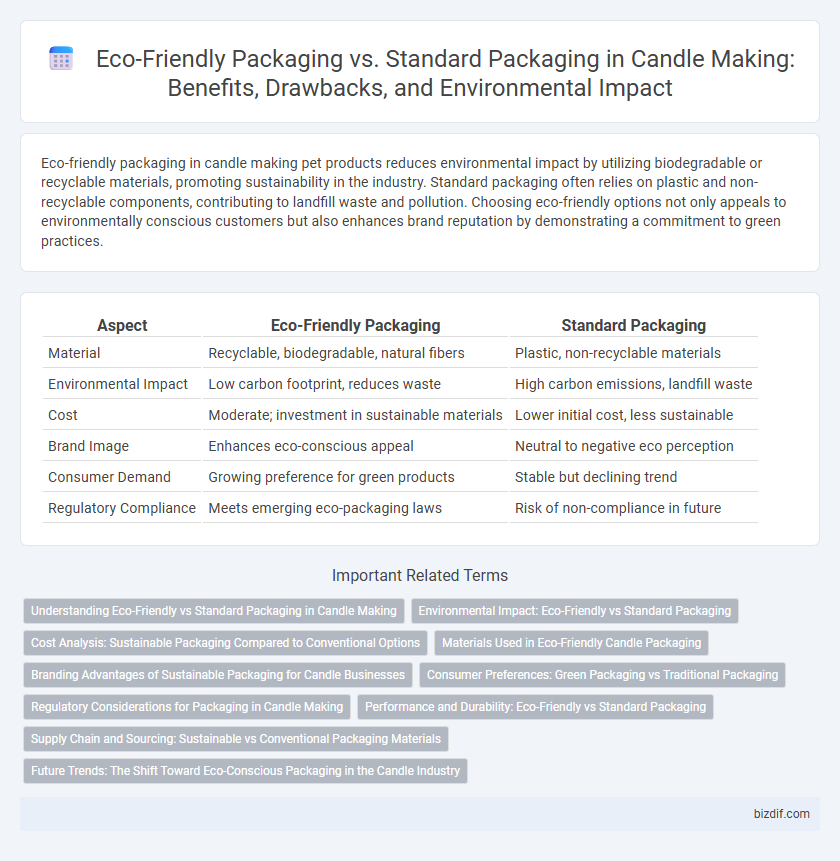Eco-friendly packaging in candle making pet products reduces environmental impact by utilizing biodegradable or recyclable materials, promoting sustainability in the industry. Standard packaging often relies on plastic and non-recyclable components, contributing to landfill waste and pollution. Choosing eco-friendly options not only appeals to environmentally conscious customers but also enhances brand reputation by demonstrating a commitment to green practices.
Table of Comparison
| Aspect | Eco-Friendly Packaging | Standard Packaging |
|---|---|---|
| Material | Recyclable, biodegradable, natural fibers | Plastic, non-recyclable materials |
| Environmental Impact | Low carbon footprint, reduces waste | High carbon emissions, landfill waste |
| Cost | Moderate; investment in sustainable materials | Lower initial cost, less sustainable |
| Brand Image | Enhances eco-conscious appeal | Neutral to negative eco perception |
| Consumer Demand | Growing preference for green products | Stable but declining trend |
| Regulatory Compliance | Meets emerging eco-packaging laws | Risk of non-compliance in future |
Understanding Eco-Friendly vs Standard Packaging in Candle Making
Eco-friendly packaging in candle making utilizes biodegradable or recyclable materials such as recycled paper, cardboard, or plant-based plastics, significantly reducing environmental impact compared to standard packaging made from non-recyclable plastics and synthetic materials. This sustainable approach not only minimizes landfill waste but also appeals to eco-conscious consumers seeking environmentally responsible products, enhancing brand reputation and marketability. Choosing eco-friendly packaging supports circular economy principles and aligns with increasing regulations on plastic use, promoting long-term sustainability in the candle industry.
Environmental Impact: Eco-Friendly vs Standard Packaging
Eco-friendly packaging for candles significantly reduces carbon emissions and minimizes landfill waste compared to standard packaging made from non-recyclable plastics and excessive cardboard. Biodegradable materials, such as recycled paper and plant-based cellulose, decompose faster and prevent toxic leachates, supporting sustainable ecosystems. Standard packaging often relies on virgin resources and contributes to longer degradation cycles, increasing environmental pollution and resource depletion.
Cost Analysis: Sustainable Packaging Compared to Conventional Options
Eco-friendly packaging for candles often involves biodegradable materials such as recycled paper, bamboo, or plant-based plastics, which typically incur higher upfront costs than standard packaging like plastic or plain cardboard. Despite the initial expense, sustainable packaging can reduce long-term costs through lower waste disposal fees and enhanced brand value, appealing to eco-conscious consumers who may be willing to pay a premium. Cost analysis reveals that investing in sustainable packaging may increase production expenses by 10-25% but offers potential savings and revenue growth through improved customer loyalty and regulatory compliance.
Materials Used in Eco-Friendly Candle Packaging
Eco-friendly candle packaging primarily utilizes biodegradable materials such as recycled paper, bamboo, and cornstarch-based plastics, reducing environmental impact compared to conventional packaging that often relies on non-recyclable plastics and synthetic foams. Natural fibers and soy-based inks are common in sustainable packaging, enhancing compostability and minimizing chemical waste. These materials not only protect the candle during shipping but also contribute to lowering carbon footprints and promoting circular economy practices in the candle industry.
Branding Advantages of Sustainable Packaging for Candle Businesses
Eco-friendly packaging enhances candle business branding by aligning products with growing consumer demand for sustainability, boosting brand loyalty and perceived value. Utilizing biodegradable, recyclable, or reusable materials signals environmental responsibility, attracting eco-conscious customers and differentiating the brand in a competitive market. Such sustainable packaging not only reduces environmental impact but also strengthens brand identity, fostering long-term customer engagement and trust.
Consumer Preferences: Green Packaging vs Traditional Packaging
Consumers increasingly prefer eco-friendly packaging for candles due to growing environmental awareness and demand for sustainable products. Studies show that 68% of candle buyers are more likely to purchase brands offering biodegradable or recyclable packaging compared to standard plastic or non-recyclable options. Green packaging not only enhances brand loyalty but also appeals to eco-conscious demographics, driving higher sales and positive brand perception.
Regulatory Considerations for Packaging in Candle Making
Regulatory considerations for packaging in candle making emphasize compliance with environmental standards such as the European Union's Packaging and Packaging Waste Directive and the U.S. Environmental Protection Agency's guidelines. Eco-friendly packaging materials like recycled paper, biodegradable plastics, and glass comply with stricter regulations on recyclability and waste reduction compared to standard packaging options. Manufacturers must ensure labeling requirements and chemical safety standards are met to avoid penalties and support sustainable consumer practices.
Performance and Durability: Eco-Friendly vs Standard Packaging
Eco-friendly packaging for candle making often uses biodegradable materials like recycled paper and plant-based plastics that provide adequate protection but may lack the long-term durability of standard packaging made from synthetic polymers and heavy-duty cardboard. Standard packaging generally offers superior resistance to moisture, impact, and temperature variations, ensuring candles remain intact during shipping and storage. However, advances in eco-friendly materials are closing the performance gap, enhancing both durability and protective qualities without compromising sustainability.
Supply Chain and Sourcing: Sustainable vs Conventional Packaging Materials
Eco-friendly packaging in candle making relies on biodegradable, recycled, or renewable materials sourced from sustainable suppliers, reducing environmental impact and supporting ethical supply chains. Conventional packaging often uses plastic, non-recyclable materials, and petrochemical-derived products, contributing to higher carbon footprints and resource depletion within the supply chain. Prioritizing sustainable packaging material sourcing minimizes waste, lowers emissions, and fosters transparency in supplier practices throughout the candle industry's logistics network.
Future Trends: The Shift Toward Eco-Conscious Packaging in the Candle Industry
The candle industry is experiencing a significant shift towards eco-conscious packaging, driven by increasing consumer demand for sustainable and biodegradable materials such as recycled paper, soy-based inks, and plant-based plastics. Companies adopting eco-friendly packaging are expected to gain a competitive edge as regulations tighten and environmental awareness grows, promoting reduced carbon footprints and minimized waste. Innovations like reusable tins and compostable wrapping are setting new standards, indicating a long-term trend favoring sustainability in candle packaging solutions.
Eco-friendly packaging vs Standard packaging Infographic

 bizdif.com
bizdif.com